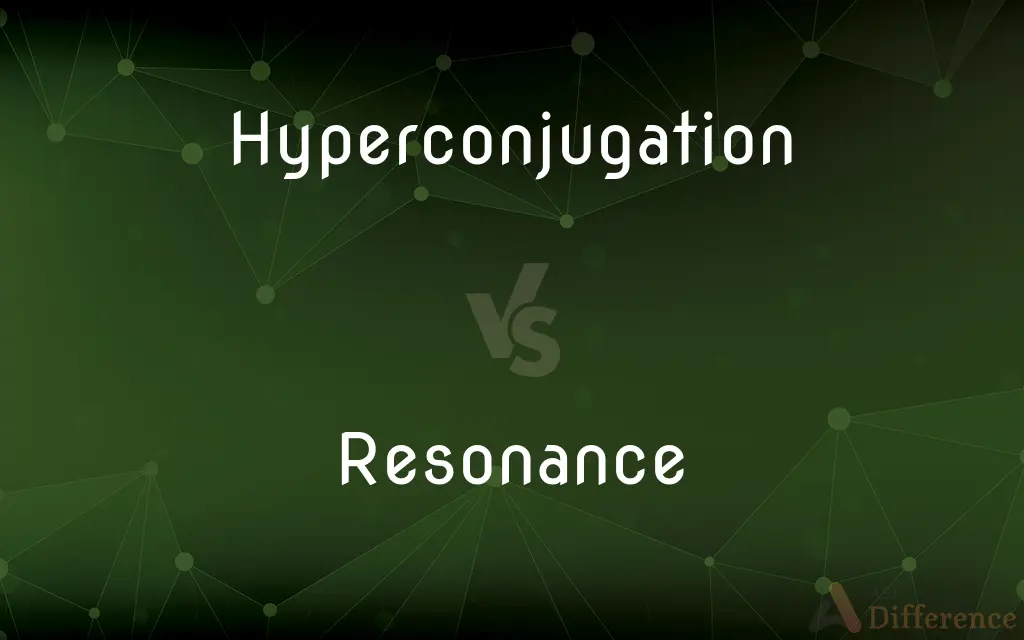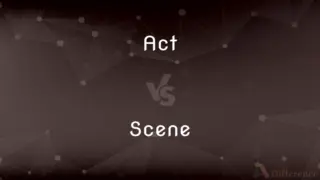Hyperconjugation vs. Resonance — What's the Difference?
By Fiza Rafique & Urooj Arif — Updated on March 10, 2024
Hyperconjugation involves electron delocalization from C-H bonds to adjacent carbocations or radicals, while resonance describes electron delocalization within a molecule through p-orbitals.

Difference Between Hyperconjugation and Resonance
Table of Contents
ADVERTISEMENT
Key Differences
Hyperconjugation is a subtle electronic effect where sigma bonds (usually C-H) adjacent to an unsaturated system or a positively charged center can donate electron density, stabilizing the system. Resonance, on the other hand, involves the delocalization of electrons across adjacent p-orbitals or pi bonds in a molecule, leading to structures that cannot be represented by a single Lewis structure.
While hyperconjugation involves the interaction of sigma bonds (σ-bonds) with an adjacent empty or partially filled p-orbital, resonance involves the delocalization of electrons in pi (π) systems. Both effects contribute to the stability of the molecule but operate through different mechanisms and parts of a molecule.
Resonance is often observed in aromatic compounds, such as benzene, and in molecules with conjugated double bonds. This effect leads to a lowering of the molecule's overall energy, making it more stable than any single structure would suggest. Resonance is crucial for understanding the behavior of many organic and inorganic compounds.
Hyperconjugation can also influence the reactivity of molecules by affecting their electronic distribution. For example, the greater the number of alkyl groups attached to a carbocation, the more hyperconjugative structures are possible, leading to increased stability of the carbocation. Resonance plays a critical role in determining the acid-base properties of molecules, the length and strength of bonds, and the color of compounds. For example, the resonance in nitrate ions (NO₃⁻) contributes to the equivalent bond lengths and strengths among the three N-O bonds.
Comparison Chart
Mechanism
Electron donation from sigma bonds
Electron delocalization in p-orbitals
ADVERTISEMENT
Involves
C-H bonds, carbocations, radicals
Conjugated pi systems, aromatic rings
Represented by
No-bond resonance structures
Multiple resonance structures
Impact
Stabilizes carbocations, radicals
Stabilizes molecules, affects properties
Example
Stability of tertiary carbocations
Benzene's equal C-C bond lengths
Compare with Definitions
Hyperconjugation
Increases the stability of carbocations and radicals by delocalizing electrons.
Alkyl groups attached to a carbocation enhance its stability through hyperconjugation.
Resonance
Characterized by the delocalization of electrons within a molecule.
Resonance in benzene leads to equal bond lengths and enhanced stability.
Hyperconjugation
Involves electron donation from sigma bonds (C-H) to adjacent unsaturated systems.
The stability of a tertiary carbocation is due to hyperconjugation with adjacent C-H bonds.
Resonance
Represented by several resonance structures to depict electron delocalization.
The acetate ion is often represented by two resonance structures indicating delocalized electrons.
Hyperconjugation
Another term for hyperconjugation, emphasizing its effect on molecular stability.
The Baker-Nathan effect explains the increased stability of certain organic molecules.
Resonance
Essential for understanding the stability of aromatic compounds like benzene.
Resonance is key to the unique properties of aromatic compounds, including their chemical reactivity.
Hyperconjugation
Affects the reactivity and electronic distribution within molecules.
Hyperconjugation affects the regioselectivity of electrophilic addition reactions in alkenes.
Resonance
Lowers the overall energy of the molecule, making it more stable.
The resonance in carboxylate ions contributes to their high acidity.
Hyperconjugation
Sometimes referred to as "no-bond resonance" due to the electron delocalization effect.
Hyperconjugation in alkenes contributes to the electron density around the double bond.
Resonance
Influences acid-base behavior, bond lengths, and compound color.
The resonance in nitrate ions results in equivalent N-O bond lengths and strengths.
Hyperconjugation
In organic chemistry, hyperconjugation (or σ-conjugation) refers to the delocalization of electrons with the participation of bonds of primarily σ-character. Usually, hyperconjugation involves the interaction of the electrons in a sigma (σ) orbital (e.g.
Resonance
Resonance describes the phenomenon of increased amplitude that occurs when the frequency of a periodically applied force (or a Fourier component of it) is equal or close to a natural frequency of the system on which it acts. When an oscillating force is applied at a resonant frequency of a dynamic system, the system will oscillate at a higher amplitude than when the same force is applied at other, non-resonant frequencies.Frequencies at which the response amplitude is a relative maximum are also known as resonant frequencies or resonance frequencies of the system.
Hyperconjugation
(organic chemistry) A weak form of conjugation in which single bonds interact with a conjugated system
Resonance
Intensification and prolongation of sound, especially of a musical tone, produced by sympathetic vibration.
Resonance
Intensification of vocal tones during articulation, as by the air cavities of the mouth and nasal passages.
Resonance
(Medicine) The sound produced by diagnostic percussion of the normal chest.
Resonance
Richness or significance, especially in evoking an association or strong emotion
"Israel, gateway to Mecca, is of course a land of religious resonance and geopolitical significance" (James Wolcott).
Resonance
(Physics) The increase in amplitude of oscillation of an electric or mechanical system exposed to a periodic force whose frequency is equal or very close to the natural undamped frequency of the system.
Resonance
(Physics) A subatomic particle having too short a lifetime to be observed directly and whose existence is inferred from a peak in the energy distribution of its decay products.
Resonance
(Chemistry) The property of a compound having simultaneously the characteristics of two or more structural forms that differ only in the distribution of electrons. Such compounds are highly stable and cannot be properly represented by a single structural formula.
Resonance
(uncountable) The quality of being resonant.
Resonance
(countable) A resonant sound, echo, or reverberation, such as that produced by blowing over the top of a bottle.
Resonance
(medicine) The sound produced by a hollow body part such as the chest cavity upon auscultation, especially that produced while the patient is speaking.
Resonance
(figuratively) Something that evokes an association, or a strong emotion; something that strikes a chord.
Emotional resonance
Resonance
(physics) The increase in the amplitude of an oscillation of a system under the influence of a periodic force whose frequency is close to that of the system's natural frequency.
Resonance
(nuclear physics) A short-lived subatomic particle or state of atomic excitation that results from the collision of atomic particles.
Resonance
An increase in the strength or duration of a musical tone produced by sympathetic vibration.
Resonance
(chemistry) The property of a compound that can be visualized as having two structures differing only in the distribution of electrons.
Resonance
(astronomy) A influence of the gravitational forces of one orbiting object on the orbit of another, causing periodic perturbations.
Resonance
(electronics) The condition where the inductive and capacitive reactances have equal magnitude.
Resonance
(sociology) A quality of human relationship with the world.
Resonance
The act of resounding; the quality or state of being resonant.
Resonance
A prolongation or increase of any sound, either by reflection, as in a cavern or apartment the walls of which are not distant enough to return a distinct echo, or by the production of vibrations in other bodies, as a sounding-board, or the bodies of musical instruments.
Resonance
A phenomenon in which a vibration or other cyclic process (such as tide cycles) of large amplitude is produced by smaller impulses, when the frequency of the external impulses is close to that of the natural cycling frequency of the process in that system.
Resonance
An electric phenomenon corresponding to that of acoustic resonance, due to the existance of certain relations of the capacity, inductance, resistance, and frequency of an alternating circuit; the tuning of a radio transmitter or receiver to send or detect waves of specific frequencies depends on this phenomenon.
Resonance
An excited state of a stable particle causing a sharp maximum in the probability of absorption of electromagnetic radiation
Resonance
A vibration of large amplitude produced by a relatively small vibration near the same frequency of vibration as the natural frequency of the resonating system
Resonance
Having the character of a loud deep sound; the quality of being resonant
Resonance
Relation of mutual understanding or trust and agreement between people
Resonance
The quality imparted to voiced speech sounds by the action of the resonating chambers of the throat and mouth and nasal cavities
Common Curiosities
How does hyperconjugation affect boiling points?
Hyperconjugation can influence molecular structure and polarity, potentially affecting boiling points indirectly.
Why are resonance structures important?
Resonance structures help visualize the delocalization of electrons in molecules, explaining their stability and properties.
Can hyperconjugation explain acidity or basicity?
Hyperconjugation can influence acidity or basicity by stabilizing charged intermediates, such as carbocations.
How does resonance affect molecular stability?
Resonance stabilizes molecules by allowing electrons to delocalize over several atoms, lowering the overall energy.
What is hyperconjugation in simple terms?
Hyperconjugation is the stabilization effect where sigma bonds (C-H) donate electrons to adjacent unsaturated systems or positively charged centers.
Can hyperconjugation occur in molecules without C-H bonds?
Hyperconjugation typically involves C-H bonds, but it can also occur with other types of sigma bonds adjacent to unsaturated systems.
Does resonance occur in all organic molecules?
Resonance occurs in molecules with conjugated systems or aromatic rings, not in all organic molecules.
What is the difference between hyperconjugation and inductive effect?
Hyperconjugation involves electron donation from sigma bonds, whereas the inductive effect is the electrostatic transmission of charge through sigma bonds.
What role does hyperconjugation play in chemical reactions?
Hyperconjugation affects the stability of intermediates, influencing the course and rate of chemical reactions.
How do you identify possible resonance structures?
Resonance structures are identified by moving electrons within conjugated pi systems or between atoms with lone pairs and pi bonds.
Is hyperconjugation a type of resonance?
Hyperconjugation is related to resonance but involves sigma bonds and is sometimes called "no-bond resonance."
Is hyperconjugation only significant in carbocations?
While especially important in carbocations, hyperconjugation also affects radicals and certain alkene and alkane stability.
How do resonance and hyperconjugation influence reactivity?
Both effects stabilize intermediates and distribute electron density, influencing the reactivity and selectivity of molecules in reactions.
Can resonance affect a molecule's geometry?
Yes, resonance can influence bond lengths and angles, affecting a molecule's geometry.
How does resonance contribute to color in compounds?
Electron delocalization in resonance can affect the absorption of light, contributing to the color of compounds.
Share Your Discovery

Previous Comparison
Warrant vs. Guarantee
Next Comparison
Act vs. SceneAuthor Spotlight
Written by
Fiza RafiqueFiza Rafique is a skilled content writer at AskDifference.com, where she meticulously refines and enhances written pieces. Drawing from her vast editorial expertise, Fiza ensures clarity, accuracy, and precision in every article. Passionate about language, she continually seeks to elevate the quality of content for readers worldwide.
Co-written by
Urooj ArifUrooj is a skilled content writer at Ask Difference, known for her exceptional ability to simplify complex topics into engaging and informative content. With a passion for research and a flair for clear, concise writing, she consistently delivers articles that resonate with our diverse audience.














































